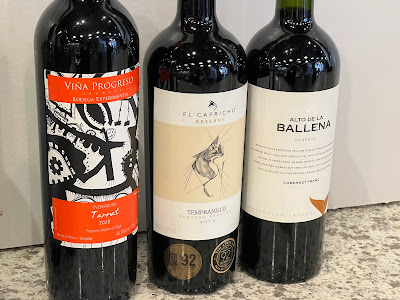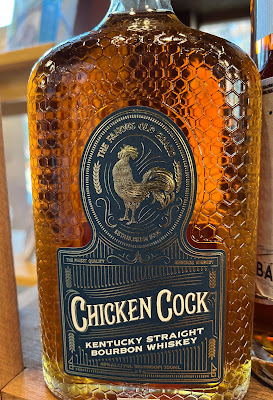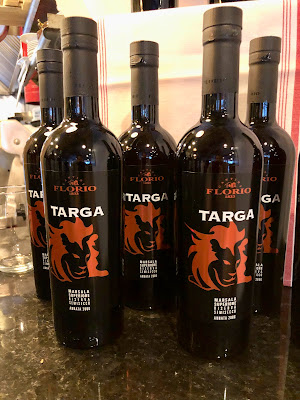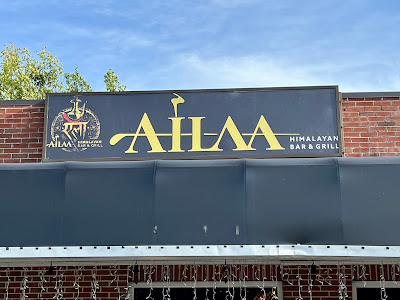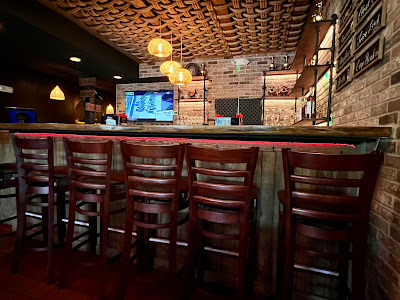According to the South Florida Sun Sentinel (FL), July 12, 1999, Ibesc Wine Distributors, located in Florida, imported the first Uruguayan wines in 1998, selling about 5,000 bottles. Guzman Castro, a 25 year old who was born in Uruguay and raised in the U.S, was the sales director for Ibesc, which was was part of International Bonded Export Services, which was founded in 1988 by Guzman's father. Initially, the Uruguayan wines were sourced from two wineries, Bodega Santa Rosa and Bodegas Castillo Viejo (both which are still in operation).
The wines included Reds, White and Sparkling wines, with grape varieties including Chardonnay, Cabernet Sauvignon, Merlot, Sauvignon Blanc and Tannat. The wines were priced from $5.50 to $15, and a number of wine tastings were held to promote the wines, especially as few people in the U.S. knew anything about wines from Uruguay. In 1999, the company hoped to increase their sales to about 30,000 bottles. It was also noted that there was an Uruguayan community in Florida of about 4,000 people.
What was the status of Uruguayan exports in 1999? The Miami Herald (FL), June 22, 1999, noted that in the first five months of the year, Uruguyan wine exports had totaled 832,000 liters and it was believed they would break their previous record, from 1998, of 1 million liters. The European Union was their primary market although Brazil was the largest single country market. Their wines had been exported to countries including: England, France, Belgium, Norway and Canada, with new markets in Japan and Peru.
Fast forward 25 years...
As the conquistadors explored South America, it's thought that the Portuguese may have been the first Europeans to reach the region of Uruguay around 1512 though Spaniards traveled to the area around 1515. Both encountered fierce opposition from the Charrúa, an indigenous, semi-nomadic people and they also learned, to their dismay, that there was no gold or silver to be found in the region. Battles against the Charrúa continued as both Portugal and Spain decided they would still try to eventually colonize the area.
By 1603, though they didn't yet possess a permanent settlement, the Spanish introduced cattle, finding a verdant land which they thought would be conducive to such ranches. Finally, in 1624, they established their first permanent settlement at Soriano on the Río Negro. During this period, Jesuit missionaries also created a number of colonies in the valley of the Rio Paraguay. The Portuguese eventually decided to battle the Spaniards for the region, and thus, around 1670, they constricted a fort at Nova Colonia do Sacramento. The battles for control of this region would continue for more than 150 years,
No one knows when grapes were first planted in Uruguay, although it's believed that Jesuit missionaries may have made their own wine in the 17th century. The first known actual documentation of Uruguayan wines wasn't until 1776. This written reference noted that Spanish explorers had brought vines from the Canary Islands to Uruguay. Not much seemed to happen with these vineyards for the next fifty years, as battles took prominence, with Portugal, Spain, Britain and Brazil all seeking to claim the area of Uruguay, The indigenous Charrúa became mostly casualties, and were largely wiped out in the massacre at Salsipuedes in 1831. Out of all these battles, Uruguay finally acquired its own independence in 1828.
Another important person in the history of wine in Uruguay is Francisco Vidiella, a former gardener from Catalonia. In 1874, he established a vineyard and winery at Colón, planting Folle Noire and Gamay Blanc, both imported from France. Because of his contributions, Folle Noire became commonly referred to as Vidiella. It seems Uruguayans like to rename grapes after important countrymen.
Many other grapes were introduced to Uruguay during this time though it wouldn't be until 1903 that the first wine laws would be enacted. Much of the wine produced at this time was for local consumption and it would not be until the 1980s that there was a major push to increase the quality of Uruguayan wine, as well as rules concerning labeling.
VC wines, which constitute about 80% of all wines, are mostly packaged in alternative packaging such as bag in box, tetrapak and glass demijohns. The most common varieties in these wines include Black Muscat, Ugni Blanc, and Isabella. Nearly all of these wines are consumed within Uruguay.
If you examine the location and climate of Uruguay, there is little question why it is an excellent location for vineyards. It is located on the same latitude as Capetown, South Africa and Adelaide, Australia. Uruguay is a relatively flat country and aspect, where you position your vineyards in relation to the sun, is much less important than in many other regions. Instead, the wind and closeness to the Atlantic Ocean are more important factors, which has led to many wineries being located close to the coast. With over 400 miles of coastline, there are plenty of places where wineries can be located.
Fast forward 25 years...
I recently attended Unexpected Uruguay, a Masterclass at the Commonwealth Wine School, presented by Peter Granoff, a Master Sommelier. Peter did an excellent job of leading the class, informing us all about Uruguay and its wines. The Masterclass provided an overview of Uruguay and its wine industry, and included a tasting of a number of their wines. My last large-scale event of Uruguayan wines was back in 2014, so it was interesting to what changes have occurred in the last 9 years. Thus, I've updated my prior articles on Uruguayan wine here for ease of reference.
************
Located in the southeasterm region of South America, between Argentina and Brazil, Uruguay (whose name means "land of the painted birds") possesses a pristine environment, with exceptionally pure water and about 410 miles of coastline. It's one of the purest eco-systems in the world. Approximately 82% of their land is dedicated to agriculture, the highest percentage of any country in the world.
The country has a population of about 3.4 million people, which is less than the population of Greater Boston. There are also approximately 12 million cattle in Uruguay, nearly 4 for each person. Uruguay is one of the largest consumers of beef per capita, and beef is also one of Uruguay's primary exports. With all the red meat they consume, it's no surprise that they love to drink red wine.
Uruguay is a progressive, peaceful, small democratic country with a GDP that's now over $18,000 per capita. They have legalized abortion, same sex marriage and cannabis. They have also made voting in national elections to be mandatory, subject to penalities for failure to vote. Their 98.7% literacy rates is one of the highest in the world, and in comparison, the U.S. only has a literacy rate of 65-85%. From the photos I've seen of Uruguay, it also is quite beautiful, with so much natural wilderness.
Let us take a look at some of the history of Uruguay and its wine industry.
As the conquistadors explored South America, it's thought that the Portuguese may have been the first Europeans to reach the region of Uruguay around 1512 though Spaniards traveled to the area around 1515. Both encountered fierce opposition from the Charrúa, an indigenous, semi-nomadic people and they also learned, to their dismay, that there was no gold or silver to be found in the region. Battles against the Charrúa continued as both Portugal and Spain decided they would still try to eventually colonize the area.
By 1603, though they didn't yet possess a permanent settlement, the Spanish introduced cattle, finding a verdant land which they thought would be conducive to such ranches. Finally, in 1624, they established their first permanent settlement at Soriano on the Río Negro. During this period, Jesuit missionaries also created a number of colonies in the valley of the Rio Paraguay. The Portuguese eventually decided to battle the Spaniards for the region, and thus, around 1670, they constricted a fort at Nova Colonia do Sacramento. The battles for control of this region would continue for more than 150 years,
No one knows when grapes were first planted in Uruguay, although it's believed that Jesuit missionaries may have made their own wine in the 17th century. The first known actual documentation of Uruguayan wines wasn't until 1776. This written reference noted that Spanish explorers had brought vines from the Canary Islands to Uruguay. Not much seemed to happen with these vineyards for the next fifty years, as battles took prominence, with Portugal, Spain, Britain and Brazil all seeking to claim the area of Uruguay, The indigenous Charrúa became mostly casualties, and were largely wiped out in the massacre at Salsipuedes in 1831. Out of all these battles, Uruguay finally acquired its own independence in 1828.
With independence came an increased interest in vineyard plantings. The oldest still-operating winery, Los Cerros de San Juan, was established in the region of Canelones in 1854. Many Italians and Spanish came to Uruguay in the 1870s, contributing their knowledge and experience to the wine industry.
Pascal Harriague (1819-1894) is said to be the Uruguayan "father of commercial winegrowing." Pascal immigrated from the French Basque region and eventually purchased an estate, La Caballada, in Salto, a town on the Rio Uruguay and it developed into a 200-hectare vineyard. In about 1870, it's alleged that he planted Tannat, a French grape from the Pyrenees, and its popularity soared.
By 1877, Tannat was being considered the national grape of Uruguay, and in honor of Pascal, Tannat became commonly referred to as Harriague. However, new research seems to cast doubt on this origin tale, indicating that Tannat may have already been planted prior to the arrival of Pascal. I'm seeking more information on this matter.
Another important person in the history of wine in Uruguay is Francisco Vidiella, a former gardener from Catalonia. In 1874, he established a vineyard and winery at Colón, planting Folle Noire and Gamay Blanc, both imported from France. Because of his contributions, Folle Noire became commonly referred to as Vidiella. It seems Uruguayans like to rename grapes after important countrymen.
Many other grapes were introduced to Uruguay during this time though it wouldn't be until 1903 that the first wine laws would be enacted. Much of the wine produced at this time was for local consumption and it would not be until the 1980s that there was a major push to increase the quality of Uruguayan wine, as well as rules concerning labeling.
************
In 1988, the National Institute for Vitiviniculture (INAVI), was established, which is now responsible for the regulation and oversight of domestic wine production, and also gathers industry data, facts and statistics. One division of INAVI is Uruguay Wine, which is responsible for promoting their wines abroad. INAVI assisted in the creation of two levels of classification for Uruguayan wine: Vino Común (VC) and Vinos de Calidad Preferente (VCP).
VC wines, which constitute about 80% of all wines, are mostly packaged in alternative packaging such as bag in box, tetrapak and glass demijohns. The most common varieties in these wines include Black Muscat, Ugni Blanc, and Isabella. Nearly all of these wines are consumed within Uruguay.
VCP wines, which are mostly exported, must meet a number of quality standards, such as being made from vinifera grapes and sold in 750ml bottles. The wines must also be analyzed and approved by INAVI. If they fail to meet these standards, then the wines must be labeled as VC. If a grape variety is referenced on a label, the wine must contain at least 85% of that grape. In addition, if a geographical region is mentioned, all of the grapes must come from that region.
Since 1885, Uruguay has been divided in 19 departments, and currently wine is grown in 17 of these departments. The top five wine-producing departments include: Canelones 66.4%, Montevideo 12.3%, Maldonado 7%, Colonia 5.1%, San Jose 4.7%, with the other departments producing less than 2%. Uruguay has a very basic appellation system, which needs improvement, and I'll note that the sub-zones are not official appellations. INAVI has recently tried to clarify the growing regions into the following: Central 109 acres, Metropolitan 12K+ acres, Northern 84 acres, North Riverside, Oceanic 1K+ acres, and Southern Riverside 722 acres.
There are approximately 211 wineries in Uruguay, with about half producing less than 100,000 bottles, and about 45 of those wineries export wine. Most of the wineries are small, family-owned operations and there are very few large companies. There are also about 1129 registered vineyards, with 71% having less than 5 hectares. Uruguay has about 14,450 acres under vine, making it less than half the size of Napa Valley. Total annual production is about 10 million cases, making them the 4th largest producer in South America.
It's said that the wines of Uruguay combine European tradition with New World technology, and are usually well balanced. As most of the wineries are small, with few large companies, they are mostly artisan operations. There are also a fair number of female wine makers in the country. As exports continue to increase, you'll be hearing more and more about Uruguayan wines, and based on my prior tasting of their wines, you'll want to drink these wines.
They consume most of the wine they produce, drinking 22 liters per capita, the most outside of Europe. They only export about 5% of their wine, though their exports have been increasing. Their largest export market is Brazil, and exports can be divided into South America 58%, the U.S. 19%, Europe 18%, and 5% Other. As Uruguayan wines become more popular in the U.S., it's likely that exports will increase.
If you examine the location and climate of Uruguay, there is little question why it is an excellent location for vineyards. It is located on the same latitude as Capetown, South Africa and Adelaide, Australia. Uruguay is a relatively flat country and aspect, where you position your vineyards in relation to the sun, is much less important than in many other regions. Instead, the wind and closeness to the Atlantic Ocean are more important factors, which has led to many wineries being located close to the coast. With over 400 miles of coastline, there are plenty of places where wineries can be located.
The Uruguayan climate is very conducive, with a predominantly maritime climate and about 1000mm of rain annually. Weather is rarely extreme and summer temperatures rarely rise over the high 80s. Frost too is rare, and snow almost never falls. The high amount of rainfall can be an obstacle but Uruguayans have learned how to adapt. Humidity too can be an issue, so aeration around the canopy and fruit is considered essential. There are approximately 100 soil variations Uruguay, although the primary soils include granite, sedimentary rock, volcanic soil, and calcareous clays.
Canelones is known for its clay-rich calcareous soils, while Montevideo is more known for the clay in its soil. Colonia possesses stony alluvial soils while Maldonado has soils rich with decomposed volcanic rock. What is most important to understand is that there is a diversity of soils within Uruguay, providing numerous different terroirs.
Technologically, Uruguay is also on the cutting edge with its dedication to georeferencing. This "applies geographic coordinates to digital images, to identify and survey all the different plots of a single vineyard. From this, a database is developed where each crop is geo-coded, giving it a unique identifier. This allows each Uruguayan wine to be traced to its exact source." Launched by INAVI in 2020, they are the only country in the world which is 100% georeferenced, and that information can be found online, although currently only in Spanish. Eventually, all of their wines will have QR codes, allowing you easy access to this information.
Georeferencing also dovetails into the issue of sustainability, an important issue for much of Uruguay, and not just in the wine industry. In 2022, 104 vineyards in Uruguay had received the Sustainable Winegrowing Certification, while in 2023, so far, this number had increased to 162 vineyards.
Their vineyards are planted with about 27% Tannat, 19% Moscatel, 11% Merlot, 10% Ugni Blanc, 4% Cabernet Franc, 3% Marselan, 2% Sauvignon Blanc, 2% Chardonnay, 1.6% Albariño, and about 20% other grapes, including Riesling, Viognier, Syrah, Arinarnoa (cross of Tannat & Cabernet Sauvignon), Nebbiolo, Tempranillo, Petit Verdot, Petit Manseng, Roussanne, Sangiovese, Zinfandel.
There are at least several wineries with experimental vineyards, researching the viability of numerous different grapes. Albariño has been garnering lots of attention, especially when grown on granitic soils, and you may see increasing amounts of acreage devoted to this grape.
The undisputed signature grape of Uruguay is Tannat, which is planted on about 7200 acres, and the country has more Tannat vineyards than the rest of the world combined. France probably has the second highest amount of Tannat vineyards though the grape has spread across the world, from Australia to South Africa. In the U.S., Tannat can be found in California, Maryland and Virginia, and in South America, Tannat is also found in Argentina, Bolivia, Peru and Brazil. To Granoff, Tannat reminds him in some respects of Touriga Nacional.
It is believed that Tannat may have originated around the 13th century, planted in the town of Madiran, though the first written mention of this grape wasn't until the 18th century. It's original home is likely in the Western Pyrenees of France, and now is primarily grown in France in the Madiran AOC. Sometime before 1870, it's believed that Basque immigrants brought Tannat vines to South America and they ended up in Uruguay. The vines adapted well to the climate of Uruguay and it quickly became considered the national grape. This reminds me of Malbec, how that French grape thrived in Argentina and became their signature grape. Tannat is not as well known as Malbec to the average wine consumer, but that could change in the future,
Tannat is easy to grow, ripens late, and has a thick skin which provides some resistance to powdery mildew and botrytis. It produces robust wines with strong tannins, dark fruit flavors and spicy notes. It is also considered to be one of the healthiest red wines as it contains 3 to 4 times more antioxidants than other red grapes, and also has a high concentration of resveratrol, the most of any red grape. In the region of Madiran, the number of men who live to their 90s is double the national average.
It is believed that Tannat may have originated around the 13th century, planted in the town of Madiran, though the first written mention of this grape wasn't until the 18th century. It's original home is likely in the Western Pyrenees of France, and now is primarily grown in France in the Madiran AOC. Sometime before 1870, it's believed that Basque immigrants brought Tannat vines to South America and they ended up in Uruguay. The vines adapted well to the climate of Uruguay and it quickly became considered the national grape. This reminds me of Malbec, how that French grape thrived in Argentina and became their signature grape. Tannat is not as well known as Malbec to the average wine consumer, but that could change in the future,
Tannat is easy to grow, ripens late, and has a thick skin which provides some resistance to powdery mildew and botrytis. It produces robust wines with strong tannins, dark fruit flavors and spicy notes. It is also considered to be one of the healthiest red wines as it contains 3 to 4 times more antioxidants than other red grapes, and also has a high concentration of resveratrol, the most of any red grape. In the region of Madiran, the number of men who live to their 90s is double the national average.
As Malbec wines in Argentina are very different from Malbec wines from Cahors, France, so are Tannat wines in Uruguay very different from Tannat wines from Madiran. Tannat wines in Uruguay tend to be softer and less tannic than that in France. The Tannat grape has transformed over the last 140+ years in Uruguay, and can create compelling wines.
In Uruguay, Tannat wine is not monolithic, but actually is produced in a number of different styles, from soft & fruity to big & bold. You'll find inexpensive, easy-drinking wines as well as high-end, terroir driven Tannats. Though there are plenty of single varietal Tannat wines, you will also find it blended with a number of other grapes, including Cabernet Sauvignon, Merlot, Cabernet Franc, Zinfandel, Syrah and Viognier. These blends often help to tame the strong tannins of the Tannat, making the wines more approachable.
In Uruguay now, you'll find many different types of wines, including Red, White, Rosé, Sparkling, Pet-Nat, Carbonic, Orange, Amphora-Aged, and more. You should seek out Uruguayan wines, and ask for them at your local wine shops. Over the course of the last ten years, I've tasted a variety of Uruguayan wines and been impressed with their quality and taste.
In Uruguay now, you'll find many different types of wines, including Red, White, Rosé, Sparkling, Pet-Nat, Carbonic, Orange, Amphora-Aged, and more. You should seek out Uruguayan wines, and ask for them at your local wine shops. Over the course of the last ten years, I've tasted a variety of Uruguayan wines and been impressed with their quality and taste.
In Part 2, I'll provide some wine reviews of the wines I tasted at this Masterclass.
